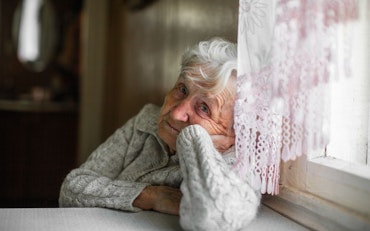New report finds poor pay and conditions the reason workers are leaving aged care
Industry superfund organisation HESTA has released research that found workers in aged care are leaving the sector due to poor wages and conditions, and HESTA is calling on the Government to improve in these areas so the workforce can continue to grow.
![<p>The three main reasons people are leaving the aged care workforce is because of poor wages, conditions and career opportunities. [Source: Shutterstock]</p>](https://agedcareguide-assets.imgix.net/news/articles/news/articles/20_5_2021-Aged-care-wages.jpg?fm=pjpg&format=auto&w=550&q=65)
The three main reasons people are leaving the aged care workforce is because of poor wages, conditions and career opportunities. [Source: Shutterstock]
This study, State of the Sector Aged Care Workforce Insights: COVID and Beyond, surveyed HESTA members working in aged care, and was released following the recent unveiling of the Federal Budget.
While growing the aged care workforce was identified by the Federal Government as one of the five pillars in their five year plan to reform the sector, there was no direct mention of raising wages, only growing the workforce.
HESTA believes the Government is missing an opportunity to build a skilled workforce to meet future demand in the aged care sector if they don’t rectify and improve on the top three reasons people are leaving aged care – wages, conditions and career opportunities.
Chief Executive Officer (CEO) of HESTA, Debby Blakey, says, “Our research shows we must act now to improve wages and working conditions if we’re to attract the skilled and talented people needed to provide high-quality care for older Australians.
“We have more than 200,000 members who work or have worked in aged care. Transforming the aged care system must start with the people central to delivering these critical services and improving outcomes for older Australians.
“Improving the quality and sustainability of aged care jobs will improve the financial future of our members working in the sector. A stronger aged care system is also vital for our members and all working Australians who will directly rely on these services as they age.”
The research found an improvement in aged care workforce sentiment after a challenging COVID-19 year, which could point to an opportunity for the sector and Government to grow the workforce.
Ms Blakey says that aged care professionals are feeling proud to work in the sector and more connected to their employers and leaders, so implementing workforce strategies now could be really effective at attracting and retaining aged care professionals.
While aged care workers are proud to be in the sector, those in aged care roles, other than managerial, were feeling underappreciated by their employers.
The study shows the rate of work appreciation of aged care workers by current or most recent employers, with 48 percent of professionals in aged care, like care workers, feeling like their work was appreciated, compared to 66 percent for those in management roles.
Comparatively, home care workers felt more appreciated by their employer, 60 percent, compared to those in residential aged care, 45 percent.
HESTA says that more than one in three aged care worker respondents did not feel appreciated, and aged care still had the lowest average rating out of all health and community services sectors in 2020 for feeling appreciated.
Ms Blakey still welcomes the announcement of aged care funding in the Budget, including $216.7 million over three years to grow and upskill the workforce and a $91.8 million commitment to train an additional 13,000 home care workers over the next two years.
However, she says even with these measures designed to improve quality and safety, including mandatory additional hours of care, it would still be difficult to attract the necessary professionals to deliver better client outcomes without addressing low rates of pay.
“The Royal Commission [into Aged Care Quality and Safety] warned of an understaffed, underpaid and poorly trained workforce. The research is clear – our members are telling us these are key concerns and would cause them to leave the industry or not recommend others work in the sector,” says Ms Blakey.
“Without strong advocates from employees in aged care, we’ll struggle to attract the people needed to lift standards and meet the expected increase in demand from our ageing population.
“Despite the critical care our members provide in aged care, too many are in poorly paid and insecure employment that leaves them in a precarious financial position that was all too apparent during COVID.”
Ms Blakey adds that there are a number of detractors around entering the sector which could create real issues when attempting to attract workers into aged care.
She says this should be a particular concern to the Government as the Royal Commission stated that the aged care workforce needs to grow by 70 percent by 2050 to maintain current staffing levels in the face of rising demand.
The shortfall in aged care workforce wage increases was picked up by the Labor Government with Opposition Leader Anthony Albanese promising to support “meaningful” aged care worker wage increases through the Fair Work Commission.
Shadow Minister for Senior Australians and Aged Care Services, Clare O’Neil, expressed her disappointment to SkyNews about the poor Budget focus on wage growth for aged care workers.
“The biggest single thing that was missing from this [Budget] response, is anything really around the structure of the workforce. If we’re going to fix aged care in this country, it is not going to be because of me… or Scott Morrison or any aged care providers or bureaucrats,” explains Minister O’Neil.
“It is going to be because of the hundreds of thousands of amazing people who work in this sector, and us being able to better support and care for them. That’s what is required so they can provide better care to the people they are looking after.
“We didn’t get anything [in the Budget] on wages for aged care workers, these are some of the poorest paid people in the Australian economy and they are doing some of the most important work. So unfortunately that response [from the Government] is leaving a lot to be desired.”
Chief Executive of Council on the Ageing (COTA) Australia, Ian Yates, agreed with the Opposition on wage increases, saying that the Government should become a party to the upcoming Fair Work Case to establish an appropriate increase in the hourly rate for aged care workers to ensure the right people are attracted to the work.
To read the full report, visit the HESTA website.










